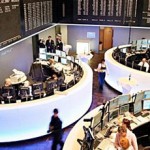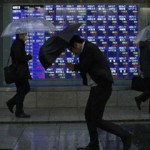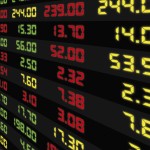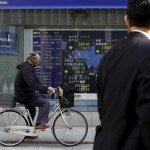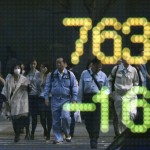Asian Shares Gain, Won Rises With Ringgit as Fed Seen on Hold
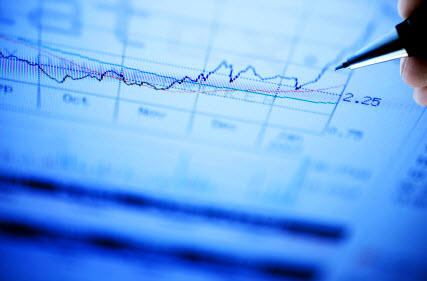
-
MSCI Asia-Pacific benchmark heads for sixth day of gains
-
Won, ringgit advance as waning Fed rate rise odds hurt dollar
European and U.S. stock futures climbed as Asian shares advanced and the South Korean won rallied to a one-year high after traders pared bets the Federal Reserve will increase interest rates this year.
Futures on the Euro Stoxx 50 Index jumped more than 1 percent as the MSCI Asia-Pacific Index of stocks rose for a sixth day. Equity benchmarks advanced in Hong Kong, Australia and South Korea and contracts on U.S. gauges rose after Friday’s weaker-than-expected reading on gross domestic product. Japanese bonds extended their rout after the Bank of Japan on Friday refrained from increasing debt purchases. Crude rebounded from its biggest monthly loss in a year and metals advanced after mixed data on China’s manufacturing.

Global equities rallied in July to their best month since March on prospects central banks will add to stimulus or refrain from reducing it. Traders peeled back bets on a U.S. rate hike this year after data Friday showed annualized GDP rose 1.2 percent last quarter, less than half the 2.5 percent projected by economists. The Bank of Japan added to its easing last week and economists forecast policy makers in Australia and England will cut their benchmark interest rates from record lows this week. Federal Reserve Bank of New York President William Dudley said investors are underestimating how many times the central bank will raise interest rates.
“The market’s saying that any rate hike is likely to be delayed further; the dollar’s weakening,” said Kelvin Tay, regional chief investment officer at UBS Group AG’s wealth management business in Singapore. “A lot of the G-4 currencies are at negative yields. That means that the emerging-market currencies, especially the higher yielding ones, will be more attractive.”
Stocks
Contracts on the European index rose 1.3 percent as of 7:22 a.m. in London. The MSCI Asia Pacific Index advanced 0.8 percent. In Australia, commodity stocks led the S&P/ASX 200 Index up 0.5 percent, while the Kospi index gained 0.7 percent in Seoul. Hong Kong’s Hang Seng Index surged 1.3 percent.
Chinese shares slid 0.8 percent. While China’s official manufacturing purchasing managers index unexpectedly fell into contraction at 49.9 for July, a private measure from Caixin Media and Markit Economics jumped to 50.6, signaling expansion, from 48.6 in June.
Futures on the S&P 500 Index climbed 0.4 percent, after the underlying benchmark rose 0.2 percent on Friday in a second day of gains.
The Topix erased earlier declines to trade little changed, following a 6.2 percent advance in July.
“The very low amount of stimulus from the BOJ does leave the market clearly expecting a significant move from Prime Minister Abe in his announcement,” Michael McCarthy, chief market strategist at CMC Markets Asia Pacific Pty in Sydney, said by phone. “Overall, we remain concerned about the impact of tighter U.S. policy, but that can easily be overwritten by a significant stimulus package from Japan.”
Currencies
The yen retreated 0.4 percent to 102.45 per dollar after soaring 4 percent last week. BOJ Governor Haruhiko Kuroda’s decision to aim low with his stimulus move raises the stakes for Abe to deliver on a pledge for “bold” fiscal stimulus on Tuesday, when the government is due to announce details of a more than 28 trillion yen ($273 billion) spending package.
The Bloomberg Dollar Spot Index, which tracks the greenback against 10 major peers, was little changed after sliding 1.3 percent last session.
For more on the task ahead for Japan’s prime minister, click here.
The won increased 1.1 percent, touching its strongest level since June 2015, while the ringgit gained a similar amount, after weakening 1 percent last month.
“Just at a time when evidence was building that the U.S. economy was in a position for the Fed to again contemplate rate hikes, some weak domestic data or a global event quite quickly scuttles those plans,” Philip Borkin, a senior economist in Auckland at ANZ Bank New Zealand Ltd., said in a note to clients.
Most other major currencies maintained their gains from Friday, with Australia’s dollar up 0.2 percent at 76.07 U.S. cents following a 1.2 percent jump, and the euro steady at $1.1166 after strengthening 0.9 percent last session.
Bonds
Japanese 10-year notes fell for a second day after the BOJ on Friday left its bond purchases at 80 trillion yen a year. The yield on the benchmark securities climbed 6 basis points to minus 0.135 percent, after jumping 8 basis points at the end of last week for the steepest increase in three years.
The U.S. 10-year yield climbed three basis points to 1.48 percent, Bloomberg Bond Trader data show.
“The movement in investor expectations towards a flatter path for U.S. short-term interest rates seems broadly appropriate,” Dudley said in remarks prepared for a speech Monday at a conference in Bali. However, “it is premature to rule out further monetary policy tightening this year,” he said.
Commodities
Crude oil for September delivery rose 0.1 percent to $41.64 a barrel in New York, after slumping 14 percent in July. U.S. producers increased drilling for a fifth week amid a glut of crude and fuel supplies that are at the highest seasonal level in at least two decades.
Most metals advanced, with nickel rising 1.1 percent and zinc climbing 0.9 percent on the London Metal Exchange.
Source: Bloomberg









